
Lluís Borrassà was a Catalan painter. He was employed by the Crown of Aragon and is widely considered to have introduced the International Gothic painting style into the Principality of Catalonia.
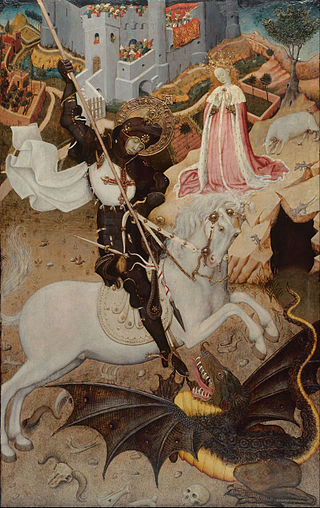
Bernat Martorell was the leading painter of Barcelona, in modern-day Spain. He is considered to be the most important artist of the International Gothic style in Catalonia. Martorell painted retable panels and manuscript illuminations, and carved sculptures and also provided designs for embroideries.

The Mond Crucifixion or Gavari Altarpiece is an oil on poplar panel dated to 1502–1503, making it one of the earliest works by Italian Renaissance artist Raphael, perhaps the second after the c.1499-1500 Baronci Altarpiece. It originally comprised four elements, of which three survive, now all separated: a main panel of the Crucified Christ with the Virgin Mary, Saints and Angels which was bequeathed to the National Gallery, London, by Ludwig Mond, and a three-panel predella from which one panel is lost; the two surviving panels are Eusebius of Cremona raising Three Men from the Dead with Saint Jerome's Cloak in the Museu Nacional de Arte Antiga, in Lisbon, and Saint Jerome saving Silvanus and punishing the Heretic Sabinianus in the North Carolina Museum of Art.

Fernando Gallego was a Castillan painter, and his art is generally regarded as Hispano-Flemish in style. Gallego was likely born in Salamanca, Spain, and worked throughout Castile and Extremadura, most notably in Ciudad Rodrigo, Plasencia, Toro, and Zamora.

Jaume Huguet was a Catalan painter.

Royal Monastery of Santa María de Sigena is a convent in Villanueva de Sigena, region of Aragon, Spain. Built between 1183 and 1208, the Romanesque church was founded by Queen Sancha of Castile, wife of Alfonso II of Aragon.

Gonzalo Pérez, or Gonçal Peris Sarrià, was a Valencian painter of the first half of the 15th century. His life is scarcely documented. He executed altarpieces and devotional paintings in his hometown, Valencia, in the late Gothic style from 1380 and 1451. Also, he worked for altarpiece in Cuenca, Murcia, Ródenas, Burgo de Osma or Puertomingalvo.
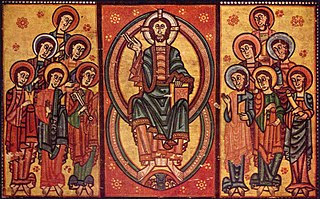
The Altar frontal from La Seu d'Urgell or of The Apostles is a Romanesque altar frontal currently exhibited at the National Art Museum of Catalonia. The work dates from the second quarter of the 12th century and comes from a church of the Bishop of La Seu d'Urgell and was acquired in 1905. It is one of the masterpieces of the collection of panel painting of the MNAC. The frontal, the item covering the front of the altar, stands out for the quality of its bright colours and because it illustrates some of the characteristics of composition in Romanesque art, such as bilateral symmetry, abstraction of the background, with no reference to space or context, and the unnatural geometrical treatment of form to be observed in the folds of the clothing. It also shows certain conventions of representation, such as so-called hierarchical perspective, which consists in representing the chief character in a larger size.
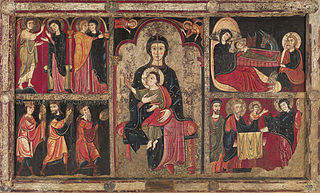
The Altar frontal from Avià is a rare Romanesque altar frontal exhibited at the National Art Museum of Catalonia in Barcelona. It is the front of the altar of the church of St. Mary of Avià, in the county of Berguedà, later moved to MNAC Barcelona, while the church has a replica in place. It is dated to the 13th century or earlier, and was painted by an unknown artist.

The Saint Augustine Altarpiece is a Catalan Gothic painting in egg tempera by Jaume Huguet and Pau Vergós made between 1462 and 1475. The long duration of the work was caused by financial reasons, and it is assumed that work was begun by Huguet and finished by other members of his workshop, in particular Pau Vergós. The altarpiece was commissioned by the guild of tanners to be placed on the altar of the Augustinian friary of Sant Agustí Vell in Barcelona, Spain. The panel measures 250 × 193 × 9.5 cm and has been in the Museu Nacional d'Art de Catalunya (MNAC) in Barcelona since 1927.

Erill la Vall Descent from the Cross is a set of seven 12th-century wooden sculptures from the Pyrenees village of Erill la Vall in Catalonia. Originally painted, it comprises a complete Romanesque Descent from the Cross sculpture group, which in Catalonia has the peculiarity that it is made up of seven figures. Two of the carvings are kept at the National Art Museum of Catalonia (MNAC) and the rest at the Vic Episcopal Museum.

The Mural paintings of the Conquest of Majorca is a group of Gothic paintings, created on 1285-1290, conserved at the National Art Museum of Catalonia, in Barcelona, Spain.

The Virgin of the Angels is a painting by Pere Serra conserved at the National Art Museum of Catalonia.
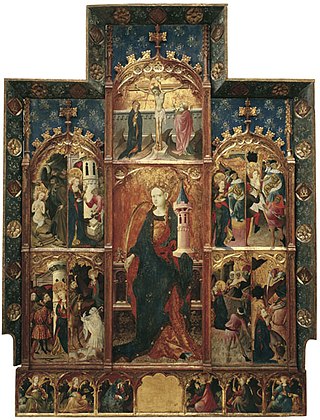
The Altarpiece of Saint Barbara is a painting by Gonzalo Pérez in the Museu Nacional d'Art de Catalunya in Barcelona.

Resurrection is a painting by Bartolomé Bermejo conserved at the National Art Museum of Catalonia.
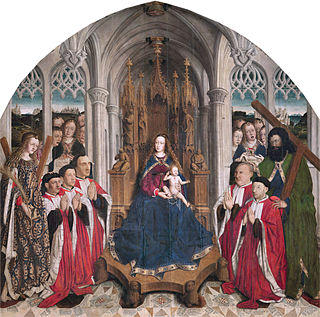
The Virgin of the Councillors is a panel painting in oils by Lluís Dalmau now in the National Art Museum of Catalonia in Barcelona. It was commissioned in 1443.
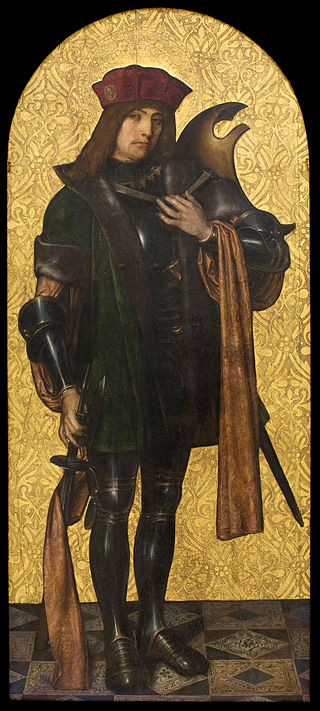
Saint Candidus is a painting by Ayne Bru conserved at the National Art Museum of Catalonia.

The Mural Paintings from the Herrera Chapel is group of mural painting by Annibale Carracci and collaborators, conserved between the National Art Museum of Catalonia and de Museo del Prado.

The Gothic altarpiece of Santes Creus is an altarpiece painted by Guerau Gener and Lluís Borrassà between 1407 and 1411. It is one of the key works of the International Gothic altarpieces in Catalonia, created for the Santes Creus Monastery. The MNAC museum retains the Nativity, crowned by the figure of St. John the Evangelist, and the Resurrection of Christ, while the rest of the tables are kept in one of the chapels of the cathedral of Tarragona. The altarpiece was commissioned to Pere Serra but apparently died without starting it. Guerau Gener, a connoisseur of València international Gothic, replaced him, but his untimely death made Lluís Borrassà, one of the major figures in the painting of the first international Catalan Gothic, to complete the project.

The Altar frontal from Tavèrnoles is Romanesque altar frontal exhibited at the National Art Museum of Catalonia in Barcelona.





















